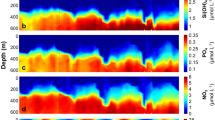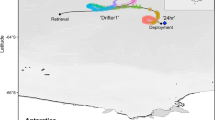Abstract
The fluxes of planktonic foraminifera (calcareous shell producing zooplankton) were examined in order to clarify temporal and regional variations in production in the upper ocean in relation to hydrographic conditions. Three time-series sediment traps were deployed in the central North Pacific along 175°E for about one year, beginning in June 1993. Trap sites were located in the subarctic, the transition, and the subtropical water masses, from north to south. The southernmost site was under the influence of the transition zone in January to May. Both temporal and regional fluxes of planktonic foraminifera showed large variations during the experiment. In the subarctic water mass, high total foraminiferal fluxes (TFFs) and high organic matter fluxes (OMFs) were observed during summer to fall, suggesting that food availability is the most important factor for the production of planktonic foraminifera. Furthermore, low TFFs during winter were ascribed to low food availability and low temperatures. The OMFs and TFFs correlated well and increased rapidly after the disruption of the seasonal thermocline during winter, peaking in late February to early March in the transition zone. In the subtropical water mass, both OMFs and TFFs remained low due to lower productivity under oligotrophic conditions. In general, TFFs show a positive correlation with OMFs during the trap experiment, suggesting that food availability is one of the factors controlling the production of planktonic foraminifera in the central North Pacific. Relatively low TFFs during summer to fall in the subtropical water mass may be caused by the thermal structure of the upper ocean. Low SST possibly reduces the production of foraminifera during winter in the subarctic region.
Similar content being viewed by others
References
Adelseck, C. G. and W. H. Berger (1975): On the dissolution of planktonic foraminifera and associated microfossils during settling and on the sea floor. Cushman Found. Foram. Res. Spec. Publ., 13, 70–81.
Bé, A. W. H. (1960): Ecology of recent planktonic foraminifera: Part 2—Bathymetric and seasonal distributions in the Sargasso Sea off Bermuda. Micropaleontology, 6, 373–392.
Bé, A. W. H. (1977): An ecological, zoogeographic and taxonomic review of recent planktonic foraminifera. p. 1–100. In Oceanic Micropaleontology, ed. by A. T. S. Ramsay, Academic Press, London.
Bé, A. W. H. and W. H. Hutson (1977): Ecology of planktonic foraminifera and biogeographic patterns of life and fossil assemblages in the Indian Ocean. Micropaleontology, 23(4), 369–414.
Berger, W. H. and D. J. W. Piper (1972): Planktonic foraminifera: differential settling, dissolution and redeposition. Limnol. Oceanogr., 17, 275–287.
Boltovskoy, E. (1969): Living planktonic foraminifera at the 90°E meridian from the equator to the Antarctic. Micropaleontology, 15(2), 237–255.
Curry, W. B., R. C. Thunell and S. Honjo (1983): Seasonal changes in the isotopic composition of planktonic foraminifera collected in Panama Basin sediment traps. Earth Planet. Sci. Lett., 64, 33–43.
Curry, W. B., D. R. Ostermann, M. V. S. Guptha and V. Ittekkot (1992): Foraminiferal production and monsoonal upwelling in the Arabian Sea: evidence from sediment traps. p. 93–106. In Upwelling Systems: Evolution since the Early Miocene, ed. by C. P. Summerhayes, W. L. Prell and K. C. Emeis, Geological Society Special Publication 64, The Geological Society, London.
Deuser, W. G. (1986): Seasonal and interannual variations in deep-water particle fluxes in the Sargasso Sea and their relation to surface hydrography. Deep-Sea Res., 33(2), 225–246.
Deuser, W. G. (1987): Seasonal variations in isotopic composition and deep-water fluxes of the tests of perennially abundant planktonic foraminifera of the Sargasso Sea: results from sediment-trap collections and their paleoceanographic significance. J. Foraminiferal Res., 17(1), 14–27.
Deuser, W. G. and E. H. Ross (1980): Seasonal change in the flux of organic carbon to the deep Sargasso Sea. Nature, 283, 364–365.
Deuser, W. G. and E. H. Ross (1989): Seasonally abundant planktonic foraminifera of the Sargasso Sea: succession, deep-water fluxes, isotopic compositions, and paleoceanographic implications. J. Foraminiferal Res., 19(4), 268–293.
Deuser, W. G., E. H. Ross, C. Hemleben and M. Spindler (1981): Seasonal changes in species composition, numbers, mass, size, and isotopic composition of planktonic foraminifera settling into the deep Sargasso Sea. Palaeogeogr., Palaeoclimatol., Palaeoecol., 33, 103–127.
Eguchi, N. O., H. Kawahata and A. Taira (1998): Seasonal succession of planktonic foraminifera in the central North Pacific ocean. In Proceedings of Techno-Ocean '98 International Symposium, ed. by Techno-Ocean '98 Organizing Committee, 195–198.
Guptha, M. V. S., W. B. Curry, V. Ittekkot and A. S. Muralinath (1997): Seasonal variation in the flux of planktonic foraminifera: sediment trap results from the Bay of Bengal, Northern Indian Ocean. J. Foraminiferal Res., 27(1), 5–19.
Hemleben, Ch., M. Spindler and O. R. Anderson (1989): Modern Planktonic Foraminifera. Springer-Verlag, New York, 363 pp.
Honjo, S. (1977): Biogenic carbonate particles in the ocean; do they dissolve in the water column? p. 269–294. In The Fate of Fossil Fuel CO 2 in the Oceans, ed. by N. R. Andersen and A. Malahoff, Plenum Press, New York.
Honjo, S. (1996): Fluxes of particles to the interior of the open ocean. p. 91–145. In Particle Flux in the Ocean, ed. by V. Ittekkot, P. Schäfer, S. Honjo and P. J. Depetris, SCOPE 57, John Wiley & Sons, Chichester.
Honjo, S. and K. W. Doherty (1988): Large aperture time-series sediment traps; design objectives, construction and application. Deep-Sea Res., 35(1), 133–149.
Honjo, S. and S. J. Manganini (1993): Annual biogenic particle fluxes to the interior of the North Atlantic Ocean; studied at 34°N 21°W and 48°N 21°W. Deep-Sea Res., 40(1/2), 587–607.
Honjo, S., J. F. Connell and P. L. Sachs (1980): Deep-ocean sediment trap: design and function of PARFLUX Mark H. Deep-Sea Res., 27, 745–753.
Honjo, S., S. J. Manganini and J. J. Cole (1982): Sedimentation of biogenic matter in the deep ocean. Deep-Sea Res., 29, 609–625.
JMA (1994): Monthly Ocean Report. Japan Meteorological Agency.
Kawahata, H., A. Suzuki and H. Ohta (1998): Sinking particles between the equatorial and subarctic regions (0°N–46°N) in the central Pacific. Geochem. J., 32, 125–133.
Lalli, C. M. and T. R. Parsons (1997): Biological Oceanography an Introduction. 2nd ed., The Open University, Butterworth-Heinemann, Oxford, 314 pp.
Levitus, S. and T. Boyer (1994): World Ocean Atlas 1994 Volume 4: Temperature. NOAA Atlas NESDIS 4, U.S. Department of Commerce, Washington, D.C. http://ingrid.ldeo.columbia.edu/SOURCES/.LEVITUS94/
Longhurst, A., S. Sathyendranath, T. Plat and C. Caverhill (1995): An estimate of global primary production in the ocean from satellite radiometer data. J. Plankton Res., 17(6), 1245–1271.
NEDO (1995): Annual Report on Northwest Pacific Ocean Carbon Cycle Study for Japanese Fiscal Year 1995, ed. by New Energy and Industrial Technology Development Organization, Ministry of International Trade and Industry, 272 pp.
Oda (1989): Planktonic foraminifera assemblages in sediment traps in the Japan Trench (JT-01, JT-02). Kaiyo Monthly, 21(4), 221–227.
Reynolds, L. and R. C. Thunell (1985): Seasonal succession of planktonic foraminifera in the subpolar North Pacific. J. Foraminiferal Res., 15(4), 282–301.
Reynolds, R. W. and T. M. Smith (1994): Improved global sea surface temperature analyses. J. Climate, 7, 929–948. http://ingrid.ldeo.columbia.edu/SOURCES/.IGOSS/.nmc/.weekly/
Roden, G. I. (1970): Aspects of the mid-Pacific transition zone. J. Geophys. Res., 75(6), 1097–1109.
Roden, G. I. (1972): Temperature and salinity fronts at the boundaries of the subarctic-subtropical transition zone in the western Pacific. J. Geophys. Res., 77(36), 7175–7187.
Sautter, L. R. and R. C. Thunell (1989): Seasonal succession of planktonic foraminifera: results from a four-year time-series sediment trap experiment in the northeast Pacific. J. Foraminiferal Res., 19(4), 253–267.
Sautter, L. R. and R. C. Thunell (1991a): Planktonic foraminiferal response to upwelling and seasonal hydrographic conditions: sediment trap results from San Pedro Basin, Southern California Bight. J. Foraminiferal Res., 21(4), 347–363.
Sautter, L. R. and R. C. Thunell (1991b): Seasonal variability in the δ 18O and δ 13C of planktonic foraminifera from an upwelling environment: sediment trap results from the San Pedro Basin, Southern California Bight. Paleoceanography, 6(3), 307–334.
Steens, T. N. F., G. Ganssen and D. Kroon (1992): Oxygen and carbon isotopes in planktonic foraminifera as indicators of upwelling intensity and upwelling-induced high productivity in sediments from the northwestern Arabian Sea. p. 107–119. In Upwelling Systems: Evolution since the Early Miocene, ed. by C. P. Summerhayes, W. L. Prell and K. C. Emeis, Geological Society Special Publication 64, The Geological Society, London.
Takahashi, K. and A. W. H. Bé (1984): Planktonic foraminifera: factors controlling sinking speeds. Deep-Sea Res., 31(12), 1477–1500.
Thunell, R. C. and S. Honjo (1981): Calcite dissolution and the modification of planktonic foraminiferal assemblages. Marine Micropaleontol., 6, 169–182.
Thunell, R. C. and S. Honjo (1987): Seasonal and interannual changes in planktonic foraminiferal production in the North Pacific. Nature, 328, 335–337.
Thunell, R. C. and L. A. Reynolds (1984): Sedimentation of planktonic foraminifera: Seasonal changes in species flux in the Panama Basin. Micropaleontology, 30(3), 243–262.
Thunell, R. C. and L. R. Sautter (1992): Planktonic foraminiferal faunal and stable isotopic indices of upwelling; a sediment trap study in the San Pedro Basin, Southern California Bight. p. 77–91. In Upwelling Systems: Evolution since the Early Miocene, ed. by C. P. Summerhayes, W. L. Prell and K. C. Emeis, Geological Society Special Publication 64, The Geological Society, London.
Thunell, R. C., W. B. Curry and S. Honjo (1983): Seasonal variation in the flux of planktonic foraminifera: time series sediment trap results from the Panama Basin. Earth Planet. Sci. Lett., 64, 44–55.
Tolderlund, D. S. and A. W. H. Bé (1971): Seasonal distribution of planktonic foraminifera in the western North Atlantic. Micropaleontology, 17(3), 297–329.
Williams, D. F., A. W. H. Bé and R. G. Fairbanks (1981): Seasonal stable isotopic variations in living planktonic foraminifera from Bermuda plankton tows. Palaeogeogr., Palaeoclimatol., Palaeoecol., 33, 71–102.
Author information
Authors and Affiliations
Rights and permissions
About this article
Cite this article
Eguchi, N.O., Kawahata, H. & Taira, A. Seasonal Response of Planktonic Foraminifera to Surface Ocean Condition: Sediment Trap Results from the Central North Pacific Ocean. Journal of Oceanography 55, 681–691 (1999). https://doi.org/10.1023/A:1007812028703
Issue Date:
DOI: https://doi.org/10.1023/A:1007812028703




